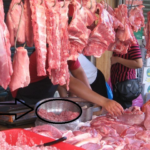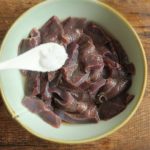Pork Neck
Báo Tổ Quốc quoted PGS.TS Nguyễn Duy Thịnh (former lecturer at the Faculty of Food Technology, Hanoi University of Technology) as saying that the neck is one of the parts that should not be eaten. When a pig is slaughtered, the neck region is where a lot of blood accumulates. In addition, the neck region is where pigs are often injected with medication.
Furthermore, the neck region contains a large number of lymph nodes and metabolic glands. This is a place where many viruses and bacteria reside, posing a risk of infection. Therefore, experts advise against buying meat from this part when purchasing pork.

Pork Lungs
Doctor Bình also stated that the lungs are one of the dirtiest organs of a pig. They are the pig’s respiratory organs. Due to the pig’s living environment being susceptible to bacteria and parasites, the pig’s lungs can easily be contaminated with a large amount of bacteria and dust, which is not good for the body if consumed.
Liver
Pig liver contains protein, iron, copper, vitamin A, and other nutrients. Consuming an appropriate amount of liver can supplement iron and vitamins, which helps with blood circulation, prevents dry eyes and fatigue.
However, pig liver is high in cholesterol. Overconsumption can lead to atherosclerosis, increasing the risk of cardiovascular and cerebrovascular diseases. Therefore, people with high cholesterol levels should avoid eating pig liver.
Brains
Many people enjoy steamed or boiled pig brains because they are soft and delicious, and are believed to be good for the brain. However, pig brains contain a lot of cholesterol. Regular consumption of this type of food can increase cholesterol and triglyceride levels in the body, leading to an increased risk of hyperlipidemia.
Kidneys
Studies have found that the kidneys of livestock, sheep, and pigs contain a considerable amount of the heavy metal cadmium. Cadmium, when ingested, is difficult to excrete from the body. Overconsumption of kidneys can affect male fertility.
Above are 5 parts of pork that experts advise against buying when going to the market. Housewives, please take note.
Things to remember when choosing good and safe pork
Pork belly, pork ribs, pork loin, pork shoulder… are the most delicious and safest parts of pork because the meat is tender, fragrant, sweet, and juicy. When making a purchase, housewives should consider choosing these parts.
When going to the market, choose pork with the following characteristics:
– The meat should have a fresh pink color and white fat. When pressed, it should feel warm, have elasticity, and not release water. When cooked, the meat should be firm and not release a lot of liquid.
– Conversely, if the meat and fat are clearly separated, with visible yellow liquid oozing out, that is excessively lean meat and should not be bought.



































